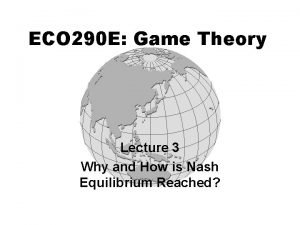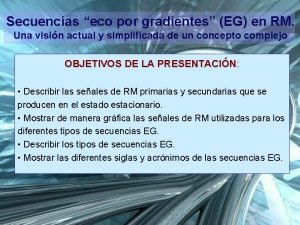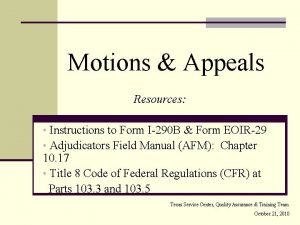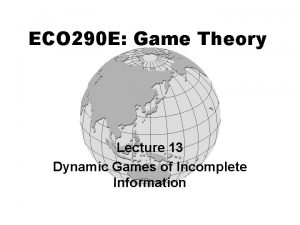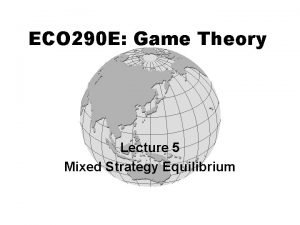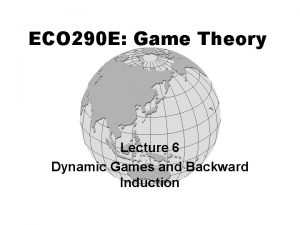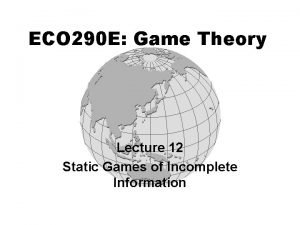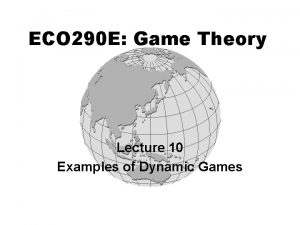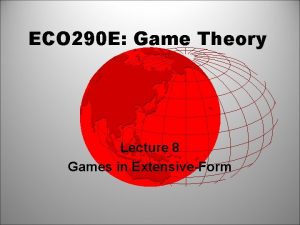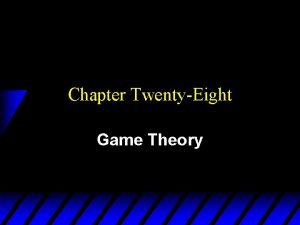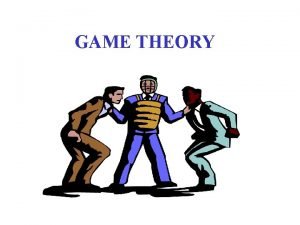ECO 290 E Game Theory Lecture 4 Applications












- Slides: 12

ECO 290 E: Game Theory Lecture 4 Applications in Industrial Organization

Review of Lecture 2 • Outcomes of games, i. e. , Nash equilibria may not be Pareto efficient. (e. g. , Prisoners’ Dilemma) • There can be multiple equilibria. (e. g. , Battle of the sexes) • One equilibrium can be less efficient than (Pareto dominated by) the other equilibrium. (e. g. , Coordination game) Þ Coordination failure

Review of Lecture 3 • When players are rational and share the correct belief about the future play, NE will emerge. • In some cases, however, NE can be reached only by rationality. Þ Dominant strategy (e. g. , PD) Þ Focal Point (e. g. , Class room experiment) Þ Iterated elimination of strictly dominated strategies (e. g. , Spatial competition model)

Spatial Competition Model • Players: Two ice cream shops • Strategies: Shop location along a beach (any integer between 0 and 100) • Payoffs: Profits=The number of customers Assumptions: • Customers are located uniformly on the beach. • Each customer goes to the nearest shop (and buys exactly one ice dream). • If both shops choose the same location, each receives half of the customers.

Nash Equilibrium • There is a unique NE in which both shops open at the middle. Why? • Choosing separate locations never becomes a NE. • Choosing the same locations other than the middle point also fails to be a NE. • If both shops choose the middle, then no one has an incentive to change the location.

Solution by Iterated Elimination • Step 1: A rational player never takes the edges, since 0 (100) is strictly dominated by 1 (99). • Step 2: 1 and 99 are never chosen if the players know their rival is rational. • Step 3: 2 and 98 are never chosen if the players know that their rival knows that you are rational. • Step 50: 49 and 51 are never chosen if the players know that their rival knows that … Þ Both players choose 50 in the end!

Common Knowledge • Each step requires a further assumption about what the players know about each other’s rationality. • We need to assume not only that all the players are rational, but also that all the players know that all the players are rational, and so on. • For an arbitrary number of steps, we need to assume that it is common knowledge that the players are rational.

Weak Predictive Power • The process often produces a very imprecise prediction about the play of the game. • Nash equilibrium is a stronger solution concept than iterated elimination of strictly dominated strategies, in the sense that the players’ strategies in a Nash equilibrium always survive during the process, but the converse is not true. Þ If the elimination processes pick up a unique strategy profile (e. g. , Spatial competition model), then that must be a NE.

Bertrand Model • Players: Two firms • Strategies: Prices they will charge • Payoffs: Profits Assumptions: • A linear demand function: P=a-b. Q • Common marginal cost, c. • The firm with lower price must serve the entire market demand. • If the firms choose the same price, then each firm sells the half of the market demand.

Bertrand-Nash Equilibrium • There is a unique NE in which both firms charge the price equal to their (common) marginal cost. Why? • Choosing different prices never becomes a NE. • Choosing the same price other than the marginal cost also fails to be a NE. • If both firms choose p=c, then no firm has an (strict) incentive to change the price.

Cournot Model • Players: Two firms • Strategies: Quantities they will charge • Payoffs: Profits Assumptions: • A linear demand function: P=a-b. Q • Common marginal cost, c. • Firms cannot decide their prices to charge, but the unique market price is determined so as to clear the market.

Important Remarks • Bertrand Cournot models are different games, i. e. , price competition vs. quality competition. • The unique equilibrium concept (=NE) can explain different market outcomes depending on the models. • That is, we don’t need different assumptions about firms’ behaviors. Þ Once a model is specified, then Nash equilibrium gives us the result of the game.
